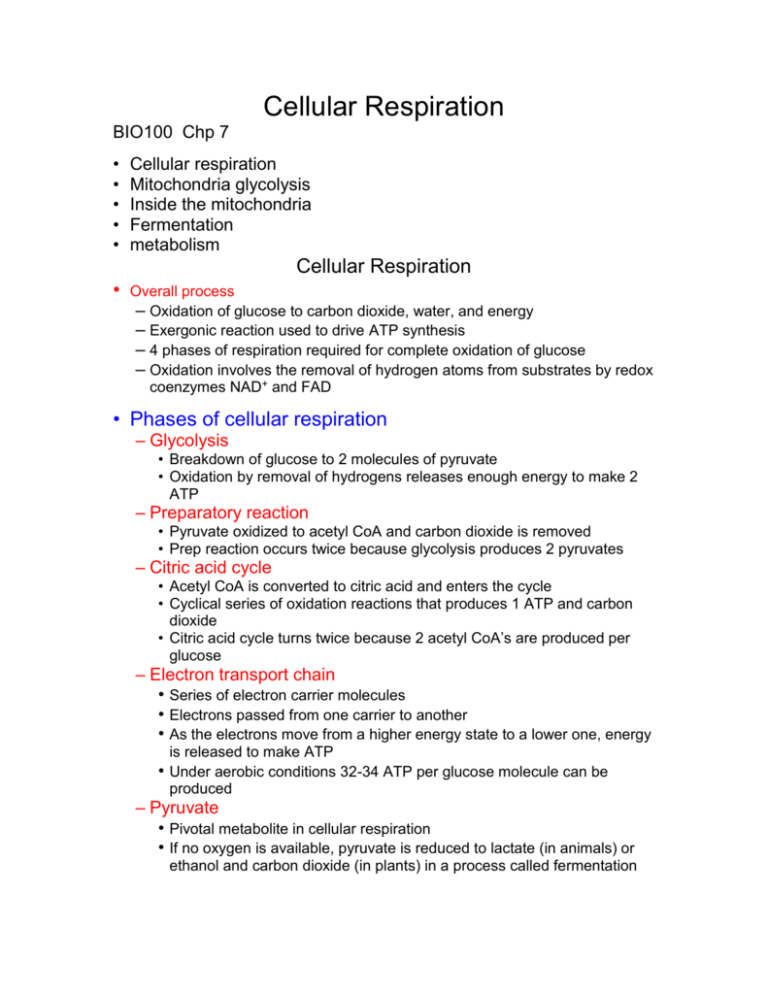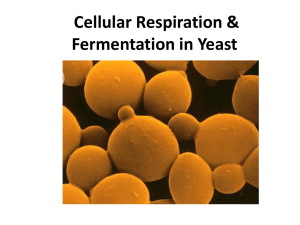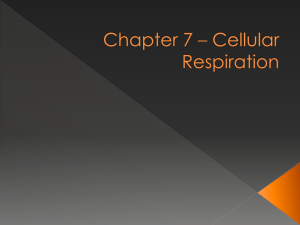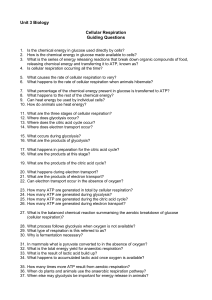Breathing, eating, and cellular respiration
advertisement

Cellular Respiration BIO100 Chp 7 • • • • • Cellular respiration Mitochondria glycolysis Inside the mitochondria Fermentation metabolism Cellular Respiration • Overall process – Oxidation of glucose to carbon dioxide, water, and energy – Exergonic reaction used to drive ATP synthesis – 4 phases of respiration required for complete oxidation of glucose – Oxidation involves the removal of hydrogen atoms from substrates by redox coenzymes NAD+ and FAD • Phases of cellular respiration – Glycolysis • Breakdown of glucose to 2 molecules of pyruvate • Oxidation by removal of hydrogens releases enough energy to make 2 ATP – Preparatory reaction • Pyruvate oxidized to acetyl CoA and carbon dioxide is removed • Prep reaction occurs twice because glycolysis produces 2 pyruvates – Citric acid cycle • Acetyl CoA is converted to citric acid and enters the cycle • Cyclical series of oxidation reactions that produces 1 ATP and carbon dioxide • Citric acid cycle turns twice because 2 acetyl CoA’s are produced per glucose – Electron transport chain • Series of electron carrier molecules • Electrons passed from one carrier to another • As the electrons move from a higher energy state to a lower one, energy is released to make ATP • Under aerobic conditions 32-34 ATP per glucose molecule can be produced – Pyruvate • Pivotal metabolite in cellular respiration • If no oxygen is available, pyruvate is reduced to lactate (in animals) or ethanol and carbon dioxide (in plants) in a process called fermentation Cellular respiration Outside the mitochondria: glycolysis • Energy-investment steps – Energy from 2 ATP is used to activate glucose – Glucose is split into 2 3-carbon G3P molecules • Energy-harvesting steps – Oxidation of G3P by removal of hydrogens – Hydrogens are picked up by NAD+ to form NADH – Oxidation of G3P and further substrates yields enough energy to produce 4 ATP by direct substrate phosphorylation • Glycolysis yields: – 4 ATP by direct substrate phosphorylation • 2 ATP were consumed in the investments steps • Net gain of ATP from glycolysis is therefore 2 ATP – 2 NADH which will carry electrons to the electron transport chain • When oxygen is available pyruvate will enter the mitochondria for further • oxidation If no oxygen is available, pyruvate will enter the fermentation pathway • Breathing, eating, and cellular respiration – Oxygen is taken in by breathing – Digested food contains glucose – Oxygen and glucose are carried to cells by the bloodstream – Glucose and oxygen enter cells where respiration occurs – Carbon dioxide is taken by the bloodstream to the lungs Relationship between breathing, eating, and cell respiration • Preparatory reaction – Produces the molecule that will enter the citric acid cycle – 3C pyruvate is converted to 2C acetyl CoA – Carbon dioxide is produced – Hydrogen atoms are removed from pyruvate and picked up to form NADH – This reaction occurs twice per glucose • Citric acid cycle – 2C acetyl group from prep reaction combines with a 4C molecule to produce 6C citrate – Oxidation of citrate by removal of hydrogens – Produces 3 NADH and 1 FADH2 – Produces 1 ATP by direct substrate phosphorylation – Cycle turns twice per glucose – Total yield: 6 NADH, 2 FADH2, 2 ATP, 4 CO • Electron transport chain (ETC) – 2 electrons per NADH and FADH2 enter ETC – Electrons are passed to series of electron carriers called cytochromes – Energy is captured and stored as a hydrogen ion concentration gradient – For each NADH enough energy is released to form 3 ATP – For each FADH2 there are 2 ATP produced – the final electron acceptor is oxygen – After receiving electrons oxygen combines with hydrogen ions to form water – as an end product ½ O2+ 2 e- + 2H+ H2O NAD+ and FAD recycle back to pick up more electrons from glycolysis, prep reaction, and citric acid cycle • The Efficiency of cellular respiration – The difference in energy content of reactants (glucose and oxygen) and products (carbon dioxide and water) is 686 kcal – ATP phosphate bond has 7.3 kcal of energy – 36 ATP are produced in respiration 36 X 7.3 = 263 kcal – 263/686 = 39% efficiency of energy capture – The rest of the energy is lost as heat Fermentation • Fermentation – Occurs when O2 is not available – Animal cells convert pyruvate to lactate – Plant cells, yeasts convert pyruvate to ethanol and CO 2 – Fermentation regenerates NAD+ which keeps glycolysis going • Advantages and Disadvantages of fermentation – Provides a low but continuous supply of ATP when oxygen is limited and only glycolysis can function – Lactate is potentially toxic to muscles, lowering pH and causing fatigue – Transported to liver where it is converted to pyruvate • This process requires oxygen • During exercise an oxygen debt is built up • Oxygen debt is the amount of oxygen “owed” to the liver to convert accumulated lactic acid to pyruvate • Energy yield of fermentation – Produces only a net of 2 ATP per glucose through direct substrate phosphorylation by allowing glycolysis to continue – Following fermentation most of the potential energy from glucose is still waiting to be released – Fermentation is a way to continue an ATP supply to cells when oxygen is in short supply Metabolism • Catabolism-break down reactions – Carbohydrates-digested to glucose for cell respiration – Fats-digested to glycerol and fatty acids • Glycerol can enter glycolytic pathway • Fatty acids metabolized to acetyl CoA which enters citric acid cycle – Proteins- deamination • Amino acids can enter pathway at different points • Anabolism- synthesis reactions – Substrates of glycolysis and citric acid cycle can be substrates for synthesis of macromolecules • G3P can be converted to glycerol • Acetyl groups can be converted to fatty acids • Some citric acid intermediates can be converted to amino acids – Anabolic reactions require the input of energy in the form of ATP generated in catabolic reactions








